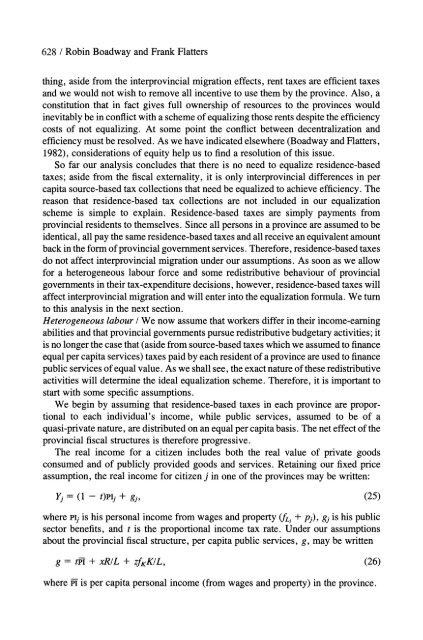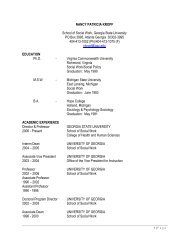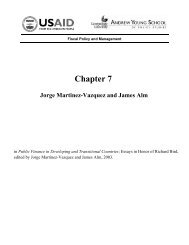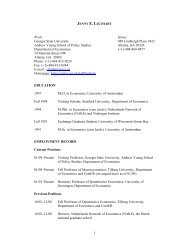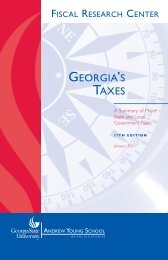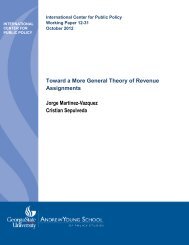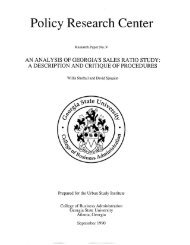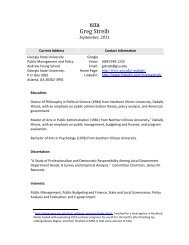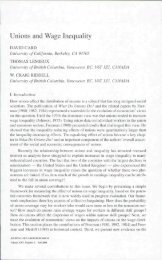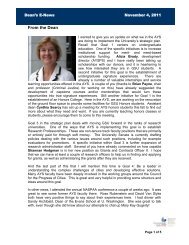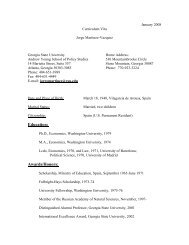Robin Boadway and Frank Flatters - Andrew Young School of Policy ...
Robin Boadway and Frank Flatters - Andrew Young School of Policy ...
Robin Boadway and Frank Flatters - Andrew Young School of Policy ...
You also want an ePaper? Increase the reach of your titles
YUMPU automatically turns print PDFs into web optimized ePapers that Google loves.
628 / <strong>Robin</strong> <strong>Boadway</strong> <strong>and</strong> <strong>Frank</strong> <strong>Flatters</strong><br />
thing, aside from the interprovincial migration effects, rent taxes are efficient taxes<br />
<strong>and</strong> we would not wish to remove all incentive to use them by the province. Also, a<br />
constitution that in fact gives full ownership <strong>of</strong> resources to the provinces would<br />
inevitably be in conflict with a scheme <strong>of</strong> equalizing those rents despite the efficiency<br />
costs <strong>of</strong> not equalizing. At some point the conflict between decentralization <strong>and</strong><br />
efficiency must be resolved. As we have indicated elsewhere (<strong>Boadway</strong> <strong>and</strong> <strong>Flatters</strong>,<br />
1982), considerations <strong>of</strong> equity help us to find a resolution <strong>of</strong> this issue.<br />
So far our analysis concludes that there is no need to equalize residence-based<br />
taxes; aside from the fiscal externality, it is only interprovincial differences in per<br />
capita source-based tax collections that need be equalized to achieve efficiency. The<br />
reason that residence-based tax collections are not included in our equalization<br />
scheme is simple to explain. Residence-based taxes are simply payments from<br />
provincial residents to themselves. Since all persons in a province are assumed to be<br />
identical, all pay the same residence-based taxes <strong>and</strong> all receive an equivalent amount<br />
back in the form <strong>of</strong> provincial government services. Therefore, residence-based taxes<br />
do not affect interprovincial migration under our assumptions. As soon as we allow<br />
for a heterogeneous labour force <strong>and</strong> some redistributive behaviour <strong>of</strong> provincial<br />
governments in their tax-expenditure decisions, however, residence-based taxes will<br />
affect interprovincial migration <strong>and</strong> will enter into the equalization formula. We turn<br />
to this analysis in the next section.<br />
Heterogeneous labour / We now assume that workers differ in their income-earning<br />
abilities <strong>and</strong> that provincial governments pursue redistributive budgetary activities; it<br />
is no longer the case that (aside from source-based taxes which we assumed to finance<br />
equal per capita services) taxes paid by each resident <strong>of</strong> a province are used to finance<br />
public services <strong>of</strong> equal value. As we shall see, the exact nature <strong>of</strong> these redistributive<br />
activities will determine the ideal equalization scheme. Therefore, it is important to<br />
start with some specific assumptions.<br />
We begin by assuming that residence-based taxes in each province are proportional<br />
to each individual's income, while public services, assumed to be <strong>of</strong> a<br />
quasi-private nature, are distributed on an equal per capita basis. The net effect <strong>of</strong> the<br />
provincial fiscal structures is therefore progressive.<br />
The real income for a citizen includes both the real value <strong>of</strong> private goods<br />
consumed <strong>and</strong> <strong>of</strong> publicly provided goods <strong>and</strong> services. Retaining our fixed price<br />
assumption, the real income for citizen j in one <strong>of</strong> the provinces may be written:<br />
Yi = (1 - t)PIj + gj, (25)<br />
where PIj is his personal income from wages <strong>and</strong> property (fLj + pj), gj is his public<br />
sector benefits, <strong>and</strong> t is the proportional income tax rate. Under our assumptions<br />
about the provincial fiscal structure, per capita public services, g, may be written<br />
g = tPiI + xR/L + zfKK/L, (26)<br />
where PI is per capita personal income (from wages <strong>and</strong> property) in the province.


